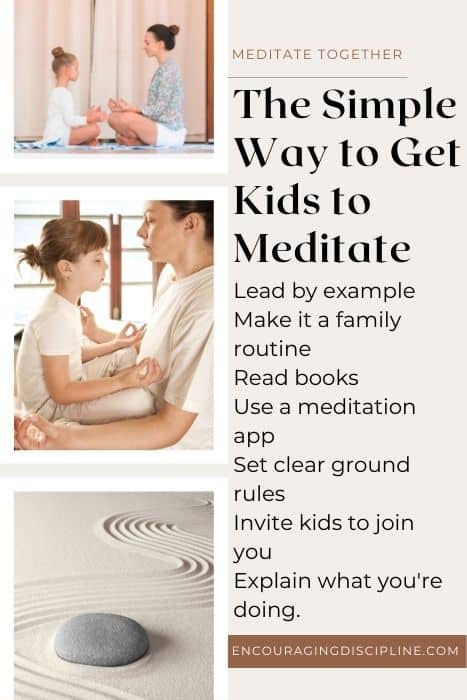The Simple Way to Get Kids to Meditate
If you’ve been trying to get your kids to meditate unsuccessfully, I can show you the easy steps that I’ve been doing to get my kids to enjoy meditation. Now they ask for meditation every night at bedtime. It’s just part of their routine.
We all read about the benefits of meditation. And while this isn’t something we grew up with and it doesn’t always come naturally, wouldn’t it be great if we could teach our kids to meditate? It would be so good for them! Wouldn’t it? But things don’t usually work that way with kids.
Let’s break this down into small steps.
Table of Contents
Can We Get Our Kids to Meditate?
The main problem is that we make meditation a “kid thing”. And our kids are not going to buy into meditation if it’s just a thing we make them do but that we are exempt from. Similarly, we can’t tell our kids “eat your vegetables because they’re good for you” while we’re eating cheese pizza for dinner.
If we want our kids to do anything, then we have to do two things: one is to lead by example, and second, make it a regular practice in our family.
First, we have to give up the idea that meditation is something our kids need to learn and do. Instead, we have to remember that our kids tend to copy what we do and not what we say. So it’s important to watch how we talk about meditation and it’s also crucial that we practice it.
Our kids learn from watching us. So instead of putting our child on a meditation program, we have to start meditating ourselves.
Secondly, we have to think of meditation as something that we as a family do routinely. We put it on our schedule and we stick to it in a very natural and matter-of-fact way. Because, … “that’s just what we do in our family.”
If we do these two things, then hopefully our kids will follow our example. And that is whether we talk about eating veggies, exercising, or meditating.
How Do We Start Meditating?
First of all, we have to acknowledge that making meditation a regular practice in our family is not that easy, especially since most of us were not brought up that way.
Build the habit
We have to build the habit ourselves. And this can be done by implementing a few simple principles. I will follow the principles outlined by James Clear in his book, Atomic Habits.
1. Start very small
Make the first steps so small and easy, you can’t say no. Begin meditating for even just a minute in the beginning while you’re building the habit. In meditation, every minute counts. And when trying to build a habit, you can’t say “I don’t have time for a minute or I can’t sit still for a minute.”
2. Increase slowly
Increase the amount of time spent meditating slowly and gradually, over weeks and months. You don’t want to push yourself and set goals that are too ambitious because they will kill your motivation. But if you increase the time very slowly, you won’t even notice how you’re growing.
3. Break it down
Break big habits down into smaller chunks. This may look something like this: you can stop and meditate for one minute (in the beginning) twice a day. Then three or four times a day for a minute each. As you feel more comfortable, you can merge the chunks together. This way, it’s easier to get to 10 minutes of meditation per day if you’ve been practicing in small chunks to build your mental muscle.
4. Get back on track
The fourth principle is very important. When you slip, don’t beat yourself up, and don’t give up. Get back on track right away. This way, it will not impact your motivation.
5. Be patient
Stick to a schedule you can sustain and remember that we’re all different. You don’t want to compare yourself to other people. You should only measure your progress against your own starting point.
So go ahead and put meditation on your schedule right now and remember to not set unrealistic goals for yourself. Slow and steady wins the race.
Make it your special time
Do not insist that your child meditate with you. This is your special time when you take care of yourself. And guess what will happen if this time is so special? Most kids often want to be a part of it.
So, be playful in the beginning and tell your child it’s your “me time” and you’ll be meditating to relax or to feel better. Then proceed to your special spot and meditate.
How Do We Get Our Kids to Meditate?
Okay, so now we’re meditating, but how do we get our kids to do it?
For our kids to be interested in meditation, we have to prepare the environment. There are a few things we can do to make meditation part of our family culture.
1. Read books about emotions and mindfulness frequently
Don’t wait until your child is “old enough” for this kind of stuff. If you wait to introduce meditation and mindfulness, and you suddenly make a big deal out of it, it’ll seem like a niche trend and kids feel weird about such things.
Instead, you want to make mindfulness and meditation part of your daily conversations and practice. It’s no big deal, it’s just normal. We do it consistently, just like eating, brushing our teeth, and sleeping.
Related: Children’s Books That Teach Mindfulness and Yoga
2. Use a meditation app
Instead of just sitting in silence with our eyes closed, I recommend using an app, like Smiling Mind, which I love and I’ll talk more about in a little bit. The reason is that, when we sit in silence, our kids find it creepy and may even get scared if they’re very young. But if they hear the voice guiding us through the meditation, they understand what’s going on.
Another benefit of our kids listening to a guided meditation as we’re doing it is that they begin to be introduced to the ideas and practices in meditation. They become familiar with breathing, the idea of feelings coming and going, and so on. And for some reason, there is power in hearing certain things from other people instead of your own parents. So they may be more inclined to try it.
Smiling Mind meditation app
My favorite meditation app for kids is Smiling Mind. It’s created by a non-profit, so it’s free of cost. You can download it on your phone or tablet easily. Then create a free account with a valid email address.
Their meditations are for children as young as 3 and all the way to adults.
What I like best about the meditations offered by Smiling Mind is that they are clearly organized by age group and needs. And you can add your favorite programs to your “Favorites” tab for quick access.
Some of the categories are:
- adults
- kids
- youth
- families
- classroom
- at work
- health workers.
Under kids, they have different subcategories, such as:
- bite-size
- sleep
- 3-6-year-olds
- 7-9-year-olds
- 10-12-year-olds
- back to school
- sports
- and much more!
It’s really easy to start kids on these meditations. Some meditations are as short as 1 minute and the longest one goes up to 17 minutes for the younger kids. The majority are between 2 and 10 minutes.
My kids really enjoy the app and they ask for it at bedtime. There are lots of meditation programs in the app. My kids like repeating the ones they’re familiar with. But we keep adding them to our favorites tab.
3. Set clear ground rules
Explain to your child that, during meditation, everyone has to be quiet. So you decide with them what they will do while you’re meditating. Also, you make it clear that they may not talk to you unless there is an emergency. And, if they do, they should expect that you will not respond.
Create about 3 rules, not too many. State the rules, then ask your child to explain back to you what they understood.
Every time, before you begin your meditation, ask your child to tell you the rules as a reminder.
Some of the things you may want to discuss are:
- You may not interrupt me.
- If you need anything (non-emergency), what are your options? Maybe you draw a picture or write me a letter about what you need or you go to another adult in the home.
- What do you do if you have an emergency? (Think bloody nose, for instance.) In this case, you are allowed to stop my meditation or go to another adult for help.
- What happens if you do not respect the rules? Let’s say your child decides to be silly and tells you there’s an emergency when there isn’t. You decide together how many chances your child gets before you enforce a consequence, such as they may not be allowed to sit with you for the next meditation session.
When kids break the rules
If your child unwillingly breaks the rules during meditation, gently remind them at the end. “Hey, remember our rules for meditation? What are they? Can you tell me?” After they tell you, continue, “It looks like you forgot one of the rules today. Do you know which one?” If your child can’t identify the rule they broke, you can tell them. Then show your trust in them by saying, “Next time you can try again, I know you’ll remember.”
It’s very important to create a positive experience around meditation if we want our kids to even give it a chance. Yelling, punishments, shaming, or coercing will not convince our kids to like meditation time.
4. Invite kids to join the meditation
When you go to start your meditation, announce it to your child. “Hey, I’m going to do my meditation now. It’ll be x minutes long.”
And now is the moment to make two offers:
Step 1
Right after you announce you will be meditating, tell your child in a very casual way, “You are welcome to join me if you want.”
If they decline the invitation, then give them a kiss (if you often do), smile, and say, “No problem. I’ll be in my special spot then. See you in a bit.” It’s good to have a little separation ritual, especially for younger kids, since this is exactly what it feels like to them.
If your child decides to join you in the meditation, be nonchalant about it. Don’t make a big deal, especially if initially they were very reluctant to try it. But at the end, make sure you tell them that you enjoyed meditating together and that you would love to do it again if they feel like it.
Step 2
If your child decides not to meditate with you, decide together what they will do while you’re meditating. Depending on their age, you can offer two choices. Pick from the ideas below or come up with other options that work for your family.
- You can sit in my lap (this may be a good option for very young kids).
- You can sit next to me.
- You can sit in the same room as me and color or read.
- You can play or read in your room.
- You can stay with another adult in the home.
Pro Tips
Only offer two choices. More than that creates overwhelm and you may be wasting more time deciding on what your child will do instead of getting to work.
I like to end the offers with some magic words: “You decide” or “It’s your choice.” By saying these words, we are sharing the power of decision with our child. They will feel more in control and less likely to attempt a power struggle.
5. If kids ask why you’re meditating
I like to tell my kids that meditation is like exercise for the mind. In order to be healthy, we have to exercise our bodies and our mind.
When we meditate, we train our mind to observe sensations, and emotions, and to find the space inside. Then, when big emotions swell in our body, we can more easily recognize them and we can let them flow without allowing them to control our body. I tell my kids this is very hard to do and we have to train our minds for many years to develop these skills. I give my kids examples of athletes who have to train a lot so they can become very good at their sport.
Conclusion
The most important thing to remember about getting kids to meditate is that we have to be really “cool” and nonchalant about meditation, we have to build the habit and demonstrate it for our kids, we have to make it a regular practice in our family, and keep it fun. Then our kids are more likely to participate.
Let me know how you get your kids to meditate. Do you have any special routines that work?








